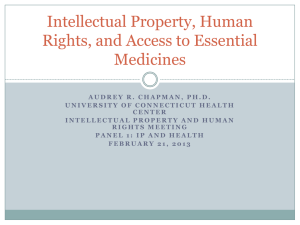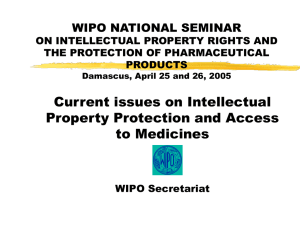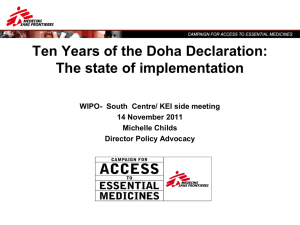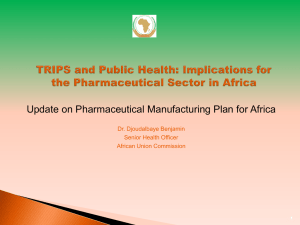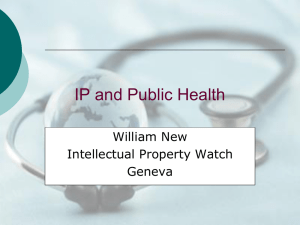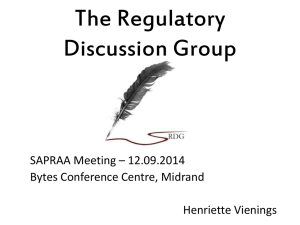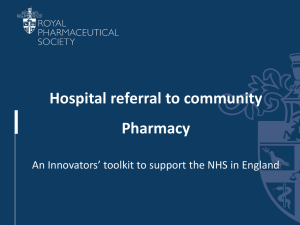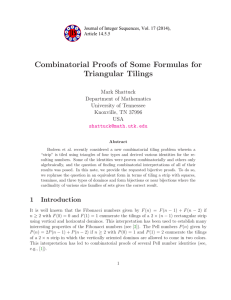Overview of regional IP challenges and strategies for access to
advertisement
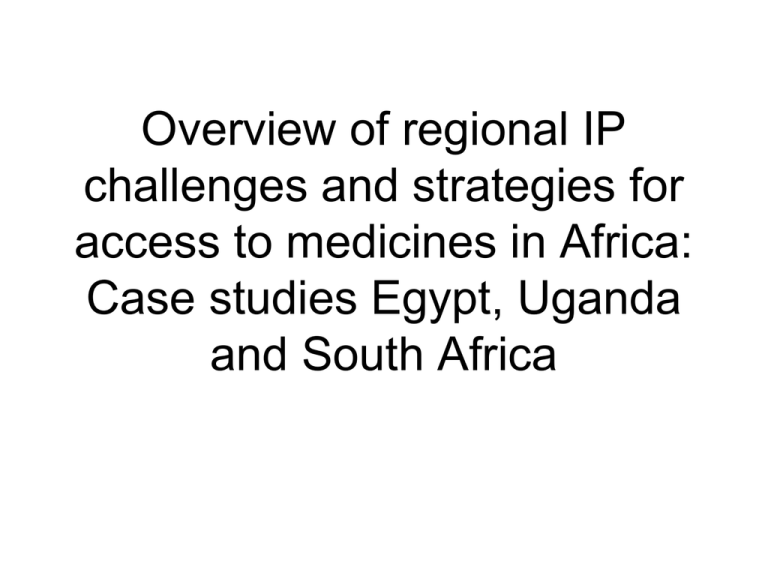
Overview of regional IP challenges and strategies for access to medicines in Africa: Case studies Egypt, Uganda and South Africa EGYPT IPRs as a legal issue -in it of itself - is just a small part of the puzzle that is hampering access to medicines: 1. TRIPS-compliant IP Law passed in 2002: A2M friendly law; 2. US-FTA negotiations haltered for a long time now: IPRs issues disagreements; 3.IPR issues are not dealt with in Court, but rather through underthe-table-deals and/or back-door blackmailing within the corporate sector (Ex: Peg-interferon alfa 2a (Mina Pharm); 4. Generic manufacturers so far agree that IPRs have not affected their work! Many different issues are hampering A2M: -Lack of trust in the Drug authorities and in the local generics’ QSE; -National Health Insurance is weak, fragmented, covers ~50% of the population; -No transparent system for pricing of medicines; -Very little field research done on availability of (affordable) medicines); EGYPT: Lessons Learnt • What actually works: HCV Huge propaganda over the disease, when it merits international attention and when you have a strikingly bad situation; • Disease-specific advocacy works much better than general “access to medicines” advocacy; • Strategic litigation does work; however, only to make the media propaganda, but unless you are behind patients’ groups, the noise does not last; • We lack empirical information on availability of (cheaper/ theoretically affordable) medicines; • The only 3 IPR-related cases brought before the Court have been won by the generic manufacturers; Uganda and the EAC Region • 1.2 million Ugandans are infected with HIV/AIDS, 6.5 percent of the population; • Over 200 000 people (39 percent of those in need) are currently accessing antiretroviral medicines; • Millions of other Ugandans require medicines to treat noncommunicable diseases like diabetes, cancer and heart diseases; • Over 90% of all medicine imports in Uganda are generic medicines; • There are 7 pharmaceuticals industries – but are all generic manufacturers including the famous quality chemicals-Cipla factory; • Made a communication to the WTO Council for TRIPS on its priority needs for technical and financial cooperation; Uganda • • • • Has a patent law passed in 1993 before the TRIPS Agreement – this is full of TRIPS Plus provisions Signed WTO Agreements in 1994 including TRIPS Since the 2000 it has been having reform of national IP laws to bring them into compliance with TRIPS - hence the Industrial Property Bill – first reading in parliament in 2009 – no progress to-date: The Draft Industrial Properties has some issues including: – Recognises 2016 but not any extension there after; – Bill allows patents on processes for new uses; – Not clear on patenting traditional medicines; – Not clear on whether naturally occurring substances can be patented; – Research exception only provides for experimental use; – Requires consent from patent owner for parallel importation; – Requires use of court to get CL which is length The East African Community (EAC) Some opportunities • Draft EAC Regional Policy and Protocol on Utilisation of Public Health Related WTO-TRIPS Flexibilities and the Approximation of National Intellectual Property Legislation 2010 • – Objective: To guide the EAC Partner States on how their national Intellectual Property (IP) legislation should be adjusted in order to enable them to fully utilise public health related WTO-TRIPS flexibilities for optimising the populations’ access to health products and medical devices. Policy: “road map” – Briefly explains public health-related TRIPS flexibilities – Provides policy recommendations as to the implementation of TRIPS flexibilities to the fullest extent – Analyses national IP legislation and identifies areas where TRIPS flexibilities have not been considered to the fullest yet • Protocol: provides guidelines to EAC countries on the use of flexibilities • The Draft EAC HIV/AIDS Bill 2010 – maintains the IP and A2M provision • Pharmaceutical association under GIZ – all generic manufactures Challenges: – The EAC anti counterfeit legislation – Regional meetings of IP enforcement (WIPO with anti counterfeiting agencies) – Training of judges in IP enforcement – A wave of South Africa South Africa has successfully used competition law to challenge the high cost of ARVs and access lower cost generic versions. - - - In 2003, TAC, S27 and partners challenged the high cost of AZT and NVP sold by GSK and BI. (Submitted affidavits showing excessive pricing). CC found that pricing was excessive and referred to tribunal at which point 3-4 generic companies were licensed to sell each medicine. The cost of a AZT, 3TC, NVP regimen dropped from over R5,000 (US$700) per month in late 90s to less than R50 (US$7) per month today. After engaging with MSD (Merck) since 2002, TAC and S27 launched a complaint with the CC in 2007, that MSD was unlawfully refusing to license on lawful terms, which blocking entry of cheaper generics and FDCs. MSD responded by licensing 4 companies and the complaint was dropped. The price of EFV dropped from R166.90 per month to R40 today. In 2008, TAC and S27 filed a complaint around the merger of Aspen and GSK. The complaint identified that competition for ABC would be impacted by the merger when the medicine came off patent. As a condition of the merger GSK was required to grant at least 5 VLs to manufacture and sell ABC. The price halved in the 2011- 2013 tender from the 2008 - 2010 price. While the filing of strong cases has worked to drive pressure companies to license, this may not be sustainable. It requires a lot of time and resources by the NGO and must be carried out on a medicine by medicine basis. TAC’s current campaign is to amend the Patents Act to fully utilize all TRIPS flexibilities: • CL conditions and procedure • Standards of patentability • Examining and opposing patents
